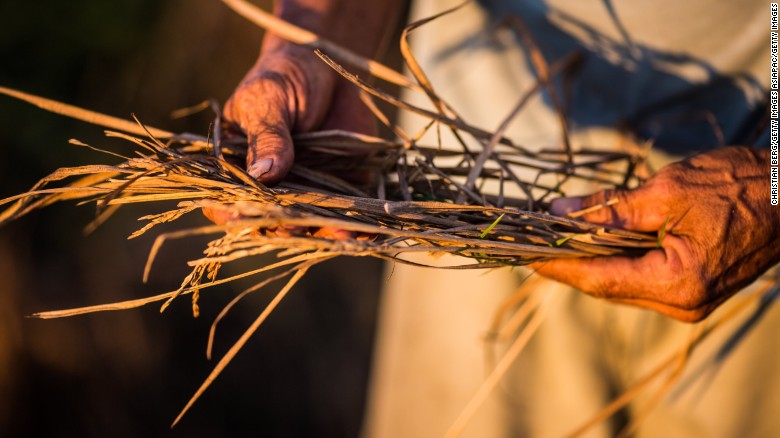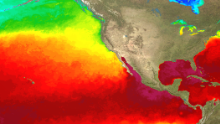Killer heatwave wreaks havoc in Southeast Asia
Drought, severe heat and water shortages are disrupting schools, killing animals and ravaging rice crops in Southeast Asia.
Thailand, Laos and Cambodia have recorded temperatures up to 44.6°C (112.4°F), beating all-time national highs, according to data from the Weather Underground, a commercial weather service. Singapore too, has seen abnormally high temperatures, while in Malaysia, lakes have dried up and vegetable output has withered.
In Cambodia, schoolchildren have vastly diminished water supplies. "It's very difficult to get water for the latrines," says Srey Norn, a 13-year-old girl from Tboung Khmum Province. "Because some wells have dried up... and I have many friends who don't come to school because it's too hot."
Hen Seha, Srey Norn's teacher, is concerned. "I have seen an increase in absenteeism of 30 or 40%" he says. "I want to install a fan but our school doesn't have any electricity."
When there are no toilets, explained Iman Morooka, Chief of Communication at UNICEF Cambodia, "Children either go in the bush... or would return home -- particularly girls -- and may not return back to the school afterwards."
In Kampong Chhnang Province, a water source for schoolchildren has become stagnant and disease-ridden. "Even if they filter this water before drinking it they will get diarrhea and fever," says Hun Heng, director of the local school support committee. "And if they use it for bathing their skin will get irritated with red spots and dryness."
The Cambodian government has responded by reducing school hours during the hottest period of the day but teachers say there have been no extra funds to buy water.
READ: Monsoon may not solve India's drought crisis
Crops die as Mekong river dries up
Meanwhile, the Mekong River -- Southeast Asia's longest -- has fallen to record lows. The Vietnamese government has reported that the river is at its lowest level since 1926. When levels are this low, water from the South China Sea intrudes inland causing a salinization of the soil. Vietnamese media have reported "major crop losses in the region."

A farmer shows rice that has been spoiled by the drought on May 04, 2016 in Ben Tre Province, Vietnam.
Thailand, one of the world's top rice producers, is also expecting poor yields because of the heat and the fact that rainfall last year was less than half of what could be expected, according to an analysis by the Economic Intelligence Centre.
If Vietnam and Thailand both fail to produce enough rice then local importers like the Philippines and Indonesia will suffer shortages and increased prices. The Philippines imported 1.9 million tons of rice last year, according to a U.S. Department of Agriculture report, with Vietnam and Thailand accounting for 53% and 5%, respectively. And the Indonesian government said last year that they expected to import one million tons of rice from Vietnam and more from Thailand.
READ: Five islands swallowed by rising seas
Singapore impacted as Malaysia's produce withers
Singapore's citizens are already feeling the pinch. Malaysia accounts for 43% of the city state's vegetable imports and is currently struggling to find water for its drought-withered fields. Vegetable exports have dropped and the prices in Singapore have risen up to 40%, according to a report in the Straits Times. The same source reports that average daily temperatures hit 30.6°C in April, breaking the all-time record.
Back in Malaysia, they have had to ration languishing water reserves as several of its major dams and reservoirs dropped to dangerous lows, according to a report in Channel News Asia. Over 250 schools were closed last month as a health precaution while fish rotted in riverbed puddles.
Animals have been dying elsewhere. The corpses of two elephants were found in Vietnam, while in Cambodia, an elderly female elephant used to carry tourists around Angkor Wat dropped dead from heat exhaustion.
The drought has also led to particularly harsh forest fires in Indonesian Borneo,killing at least nine orangutans. Seven orphans of the endangered species had to be rescued by workers from the Nyaru Menteng Orangutan Rehabilitation Center.
READ: Why this El Nino could be the worst ever
Worst El Nino in decades?
Scientists say this year's drought is one of the worst in decades.
"The current drought in Southeast Asia is very serious," says Maximiliano Herrera, a climatologist from Costa Rica. "It can be compared to the last strong El Ninos of 1998 and 1983, but in Thailand the current drought... [is] the most serious since 1983."
"This is one of the worst droughts in more than 20 years," agrees Professor Jin-Yi Yu, from the Department of Earth System Science, University of California.
El Nino is a climate cycle created when warm waters in the Pacific Ocean shift further east than usual, causing storms in the Americas and dry weather in Southeast Asia. This year's El Nino is tied for the strongest on record.
But Andrew Hoell, a meteorologist from the National Oceanic & Atmospheric Administration, a U.S. government research organization, differs: "This drought has been weaker than most El Nino-related droughts," he says. "It appears as if the region actually dodged a bullet, since it was quite a bit wetter region-wide than usual during El Nino."
Hoell was referring to the November to February period, which he said is when El Nino typically creates drought. He added that he did not have data for March to April 2016, and said perhaps the drought was strongest at that time.
El Nino is currently fizzing out and, in Kampong Chhnang, a little rain has already given a slight flush of green to the arid land. Now the region waits to see if climatologists are correct in their predictions of an equally strong La Nina -- an opposing weather system that brings storms and flash floods.
"[The] probability is very high," warns Hoell.
News Courtesy: www.cnn.com











